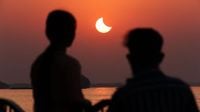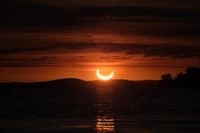On Saturday, March 29, 2025, a partial solar eclipse will grace the skies of the northern hemisphere, offering a captivating sight for millions. This celestial event, while not as dramatic as the total eclipse that captivated audiences in 2024, will still provide a unique opportunity for viewers across various regions to witness the moon partially obscuring the sun. The eclipse will be particularly stunning at sunrise in eastern North America, where observers may catch a glimpse of the sun appearing to grow a pair of "devil's horns" as it rises.
The partial solar eclipse will be visible at sunrise in eastern North America and at sunset in Siberia, Russia. In Europe, viewers will be able to see the eclipse around mid-morning. However, it is important to note that no eclipse will be visible west of Toronto, Canada, and Washington, D.C. In Europe, most regions will experience only about a 20 percent obscuration of the sun, with the exception of Greenland and Iceland, which may see more significant coverage.
For those in the northeastern United States, the eclipse will be particularly impressive. The extreme northeastern part of the U.S. is expected to see up to 89 percent of the sun covered, while the Nunavik region of Quebec will experience a maximum obscuration of 94 percent. In Bar Harbor, Maine, the sun will rise at 6:19 AM, with the maximum eclipse occurring just three minutes later at 6:22 AM, obscuring 80 percent of the sun. The partial eclipse will conclude at 7:11 AM.
According to Time and Date, only about 44,800 people will witness a 90 percent partial eclipse, while 3,820,000 are expected to see an 80 percent obscuration. This is a stark contrast to the 30 million people who were in the path of totality during the 2024 eclipse, highlighting the limited visibility of this upcoming event.
The global eclipse will kick off at 4:50 AM ET (8:50 AM UTC), with the maximum eclipse occurring at 6:47 AM ET (10:47 AM UTC) and the event wrapping up at 8:43 AM ET (12:43 PM UTC). However, the duration of the eclipse will vary depending on the viewer's location and the timing of sunrise or sunset. For instance, in Washington, D.C., only 1.2 percent of the sun will be obscured at 6:59 AM ET.
Weather conditions may pose a challenge for viewers, particularly in the northeastern United States, where cloud cover, rain, and even snow could obscure the sky. Chris Dolce, a senior digital meteorologist at The Weather Channel, has warned of these potential weather-related issues, which could hinder visibility.
Even though it is a partial eclipse, eye protection is essential. Looking directly at the sun, even when partially obscured, can cause serious eye damage. The American Astronomical Society (AAS) emphasizes that solar viewers from the 2024 eclipse, if undamaged, are still safe to use. They advise checking for any rips, tears, or scratches on the lenses before using them. If you no longer have your eclipse glasses, they can be purchased online, but it's crucial to ensure they meet the ISO 12312-2:2015(E) international safety standard.
One of the exciting aspects of this eclipse is the potential to see the "devil horns" phenomenon. This occurs when the crescent sun rises low on the horizon, creating a striking visual effect. Ideal locations for viewing this unique feature include Maine, New Brunswick, and Quebec.
Additionally, the sun is currently experiencing a peak in solar activity, having reached its highest level in October 2024. This heightened solar activity means that sunspots may be visible during the eclipse, adding to the spectacle for those using solar binoculars or telescopes.
For those not in the path of the eclipse or without protective eyewear, there are options to watch the event online. Timeanddate.com will provide a live stream beginning at 5:30 AM EDT, showcasing the eclipse from various locations. The stream will feature views from St. John's, Newfoundland and Labrador, where the eclipse will peak at around 7:53 AM EDT, with 82 percent coverage of the solar disk. The partial eclipse over Newfoundland will conclude about an hour later.
Additionally, viewers in Europe can tune in to see the eclipse from locations such as Siena, Italy, which will experience a maximum eclipse of about 5 percent at noon local time. Other locations in Norway, including Kristiansand and Skibotn, will see 30 percent and 37 percent obscuration, respectively. The Royal Observatory Greenwich in London will also host a live stream of the eclipse, peaking at around 11:03 AM local time with approximately 40 percent coverage.
After the March 29 eclipse, the next opportunity to witness a solar eclipse from North America will be on August 12, 2026. This upcoming eclipse will be a partial eclipse for much of North America but will appear as a total solar eclipse in parts of Spain, Iceland, Greenland, Russia, and a small area of Portugal.
As the excitement builds for the partial solar eclipse on March 29, enthusiasts and casual observers alike are encouraged to prepare for this celestial event. Whether watching from the comfort of home or venturing outside to catch a glimpse, this eclipse promises to be a memorable experience.


